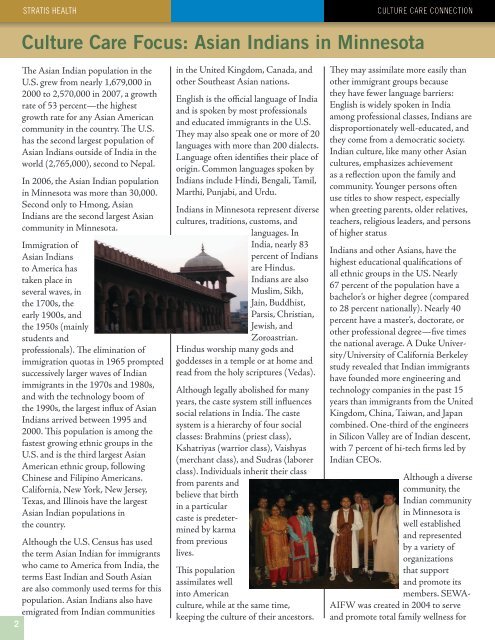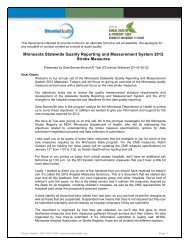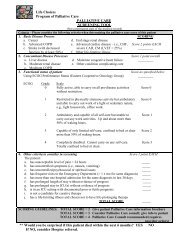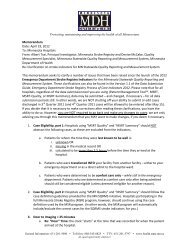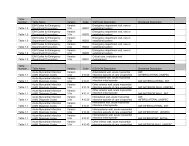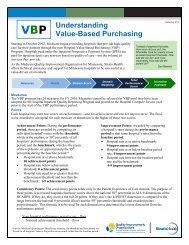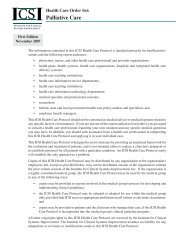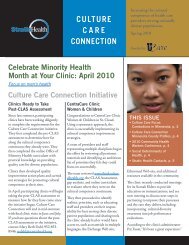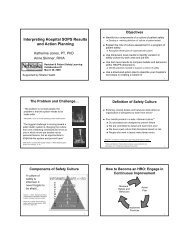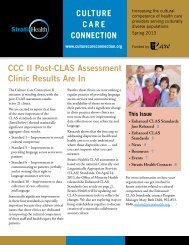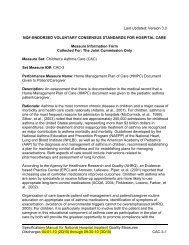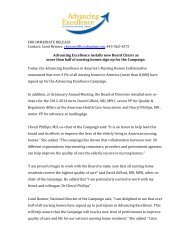Culture Care ConneCtion - Stratis Health
Culture Care ConneCtion - Stratis Health
Culture Care ConneCtion - Stratis Health
Create successful ePaper yourself
Turn your PDF publications into a flip-book with our unique Google optimized e-Paper software.
StratiS HealtH <strong>Culture</strong> <strong>Care</strong> Quality <strong>ConneCtion</strong> update<br />
<strong>Culture</strong> <strong>Care</strong> Focus: Asian Indians in Minnesota<br />
The Asian Indian population in the<br />
U.S. grew from nearly 1,679,000 in<br />
2000 to 2,570,000 in 2007, a growth<br />
rate of 53 percent—the highest<br />
growth rate for any Asian American<br />
community in the country. The U.S.<br />
has the second largest population of<br />
Asian Indians outside of India in the<br />
world (2,765,000), second to Nepal.<br />
In 2006, the Asian Indian population<br />
in Minnesota was more than 30,000.<br />
Second only to Hmong, Asian<br />
Indians are the second largest Asian<br />
community in Minnesota.<br />
Immigration of<br />
Asian Indians<br />
to America has<br />
taken place in<br />
several waves, in<br />
the 1700s, the<br />
early 1900s, and<br />
the 1950s (mainly<br />
students and<br />
professionals). The elimination of<br />
immigration quotas in 1965 prompted<br />
successively larger waves of Indian<br />
immigrants in the 1970s and 1980s,<br />
and with the technology boom of<br />
the 1990s, the largest influx of Asian<br />
Indians arrived between 1995 and<br />
2000. This population is among the<br />
fastest growing ethnic groups in the<br />
U.S. and is the third largest Asian<br />
American ethnic group, following<br />
Chinese and Filipino Americans.<br />
California, New York, New Jersey,<br />
Texas, and Illinois have the largest<br />
Asian Indian populations in<br />
the country.<br />
Although the U.S. Census has used<br />
the term Asian Indian for immigrants<br />
who came to America from India, the<br />
terms East Indian and South Asian<br />
are also commonly used terms for this<br />
population. Asian Indians also have<br />
emigrated from Indian communities<br />
2<br />
2<br />
in the United Kingdom, Canada, and<br />
other Southeast Asian nations.<br />
English is the official language of India<br />
and is spoken by most professionals<br />
and educated immigrants in the U.S.<br />
They may also speak one or more of 20<br />
languages with more than 200 dialects.<br />
Language often identifies their place of<br />
origin. Common languages spoken by<br />
Indians include Hindi, Bengali, Tamil,<br />
Marthi, Punjabi, and Urdu.<br />
Indians in Minnesota represent diverse<br />
cultures, traditions, customs, and<br />
languages. In<br />
India, nearly 83<br />
percent of Indians<br />
are Hindus.<br />
Indians are also<br />
Muslim, Sikh,<br />
Jain, Buddhist,<br />
Parsis, Christian,<br />
Jewish, and<br />
Zoroastrian.<br />
Hindus worship many gods and<br />
goddesses in a temple or at home and<br />
read from the holy scriptures (Vedas).<br />
Although legally abolished for many<br />
years, the caste system still influences<br />
social relations in India. The caste<br />
system is a hierarchy of four social<br />
classes: Brahmins (priest class),<br />
Kshatriyas (warrior class), Vaishyas<br />
(merchant class), and Sudras (laborer<br />
class). Individuals inherit their class<br />
from parents and<br />
believe that birth<br />
in a particular<br />
caste is predetermined<br />
by karma<br />
from previous<br />
lives.<br />
This population<br />
assimilates well<br />
into American<br />
culture, while at the same time,<br />
keeping the culture of their ancestors.<br />
They may assimilate more easily than<br />
other immigrant groups because<br />
they have fewer language barriers:<br />
English is widely spoken in India<br />
among professional classes, Indians are<br />
disproportionately well-educated, and<br />
they come from a democratic society.<br />
Indian culture, like many other Asian<br />
cultures, emphasizes achievement<br />
as a reflection upon the family and<br />
community. Younger persons often<br />
use titles to show respect, especially<br />
when greeting parents, older relatives,<br />
teachers, religious leaders, and persons<br />
of higher status<br />
Indians and other Asians, have the<br />
highest educational qualifications of<br />
all ethnic groups in the US. Nearly<br />
67 percent of the population have a<br />
bachelor’s or higher degree (compared<br />
to 28 percent nationally). Nearly 40<br />
percent have a master’s, doctorate, or<br />
other professional degree—five times<br />
the national average. A Duke University/University<br />
of California Berkeley<br />
study revealed that Indian immigrants<br />
have founded more engineering and<br />
technology companies in the past 15<br />
years than immigrants from the United<br />
Kingdom, China, Taiwan, and Japan<br />
combined. One-third of the engineers<br />
in Silicon Valley are of Indian descent,<br />
with 7 percent of hi-tech firms led by<br />
Indian CEOs.<br />
Although a diverse<br />
community, the<br />
Indian community<br />
in Minnesota is<br />
well established<br />
and represented<br />
by a variety of<br />
organizations<br />
that support<br />
and promote its<br />
members. SEWA-<br />
AIFW was created in 2004 to serve<br />
and promote total family wellness for


